South Bank at Quarry Trails
- 91 units available
- Studio • 1 bed • 2 bed • 3 bed
- Amenities
In unit laundry, Patio / balcony, Granite counters, Pet friendly, Stainless steel, Walk in closets + more

In the cold winter months, there's nothing cozier than a warm fireplace. But how do you find an apartment with one? Or add one to an apartment that doesn't have a built-in fireplace?
Whether you're apartment hunting or you already have a fireplace in your apartment, here's everything you need to know about operating them safely. We've also chosen six type of fireplaces that are safe for apartments and put them in the order that we think is best for most renters. Finally, we cover some of the pros and cons of investing in an apartment fireplace.
The safest type of fireplace to have in an apartment is one that is already built into the unit. However, in addition to that option, you can also choose from among a number of chimney-less fireplaces to set up in your rental unit. These fireplaces do not require ventilation and, when used properly, are believe not to pose any additional fire hazard. However, we do not recommend all of these units, and you'll see why below.
Also, you should always check your lease, however, to make sure that these products are not explicitly banned. When in doubt, ask your landlord first.
When fireplaces come built into an apartment, they are generally considered an upgraded amenity, meaning you might have to pay extra for it. If that's the case, you can inquire at the time of the tour about fees for apartments with fireplaces versus those without. If you have a built-in, then these are the types you're likely to encounter:
A gas fireplace burns natural gas or propane with gas logs and real flames, mimicking the look of a traditional fireplace. Instead of logs, a modern gas-burning fireplace may light up from stones or a decorative arrangement.
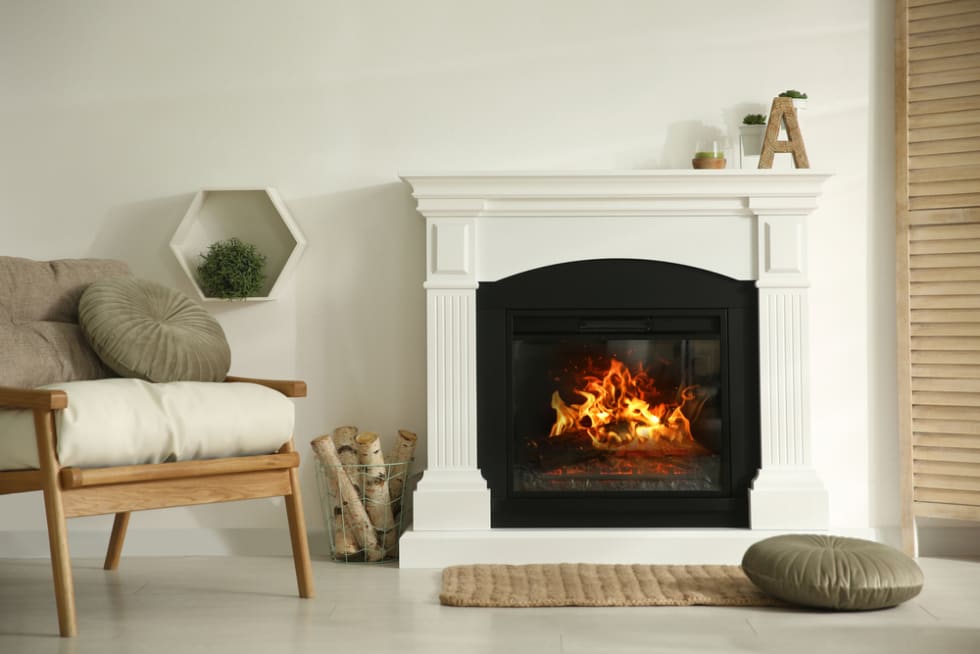
While it’s unusual to find working fireplaces that burn wood in apartments, they exist. You may find them in cities like New York or Boston with older apartment buildings and brownstones. Some single-family homes for rent or townhomes may also come equipped with wood-burning fireplaces. However, it’s not uncommon for landlords to forbid their use or close them off permanently for safety reasons.
In some cases, you may find electric fireplaces already installed in your unit (though as you'll see below, it's an option we recommend to those without built-ins as well). An electric fireplace is essentially an electric heater that looks like a real wood, coal, or gas-burning fireplace. It still produces some heat but does not require any venting of any kind. However, you may need a special outlet installed to accommodate the fireplace's electrical current.
For renters without built-in fireplaces, our first recommendation is the electric, stand-alone fireplace. As we noted above, electric fireplaces are essential heaters made to look like open flames, so they pose no immediate fire hazard. Just as importantly, they are easy to install without causing any damage to your apartment, and they come in a range of highly affordable to luxury options. You can find electric fireplaces for as little as under $300 all the way up to $4,000 or more.

For another really safe option, water vapor fireplaces are high on the list. These devices use the combination of water vapor and carefully placed LEDs to create very realistic looking flames that give off no heat, meaning they are completely safe to use. The downside of this option is that these fireplaces usually require a waterline hookup and can be very expensive, usually several hundred or several thousand dollars.
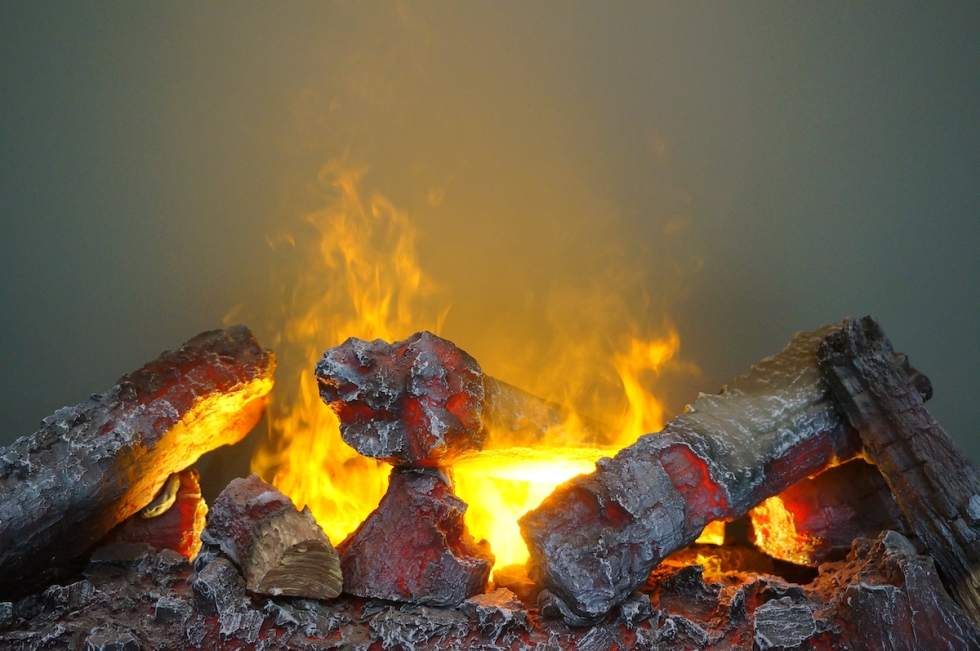
Finally, ventless gas can be a good option for renters who have gas hookups and a good relationship with their landlord. While you'll need your landlords permission to install this type of fireplace (it'll have to be hooked up to your gas line), it doesn't require a chimney or ventilation, so you're safe to use it in an apartment. Ventless gas is the least convenient option, however, because it's both expensive and requires professional installation.
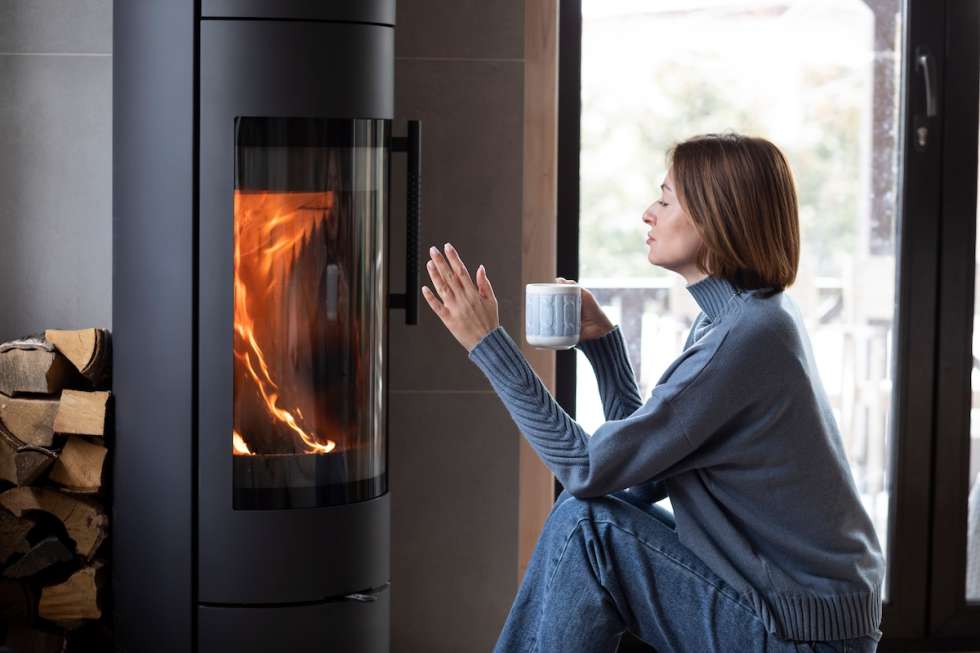
Our last two options are often marketed to renters, but we do not recommend them. Ethanol is a popular type of fireplace that may look similar to electric fireplaces; however, these are powered by ethanol (alcohol), which produces a real flame. There are nationwide reports covering a variety of safety hazards related to ethanol products, including ethanol "jets" that cause a large, powerful flame and other accidents that can lead to fires or severe burns. Because ethanol is a powerful fuel source, and because this type of fireplace produces an open flame, we do not recommend it for renters.
Gel fireplaces are similar to ethanol in that they require a powerful fuel source that produces an open flame. There have also been reported injuries across the country from these devices. Therefore, we do not recommend them for renters.
While gas and electric fireplaces look similar, electric fireplaces have fake, though realistic-looking, flames. Gas fireplaces are also ventless and produce real games. Electric fireplaces typically don't have the same heat as the alternatives, but they are also more energy-efficient than gas options.
Before you settle on an apartment fireplace, know some of the pros and cons and what to expect.
Fireplaces are warm and inviting, even during warmer months. There's nothing like coming home and cozying up around a fire with a cocktail or hot tea.
Fireplaces can reduce your utility bills by warming up your apartment. You can stay warm, keep your heat off for longer periods of time, and enjoy your time relaxing around your fireplace.
A fireplace makes the perfect focal point for your apartment when entertaining guests. Instead of sitting around the TV, your friends and family can watch the fire and listen to your favorite soundtrack.
Many apartment fireplaces are ventless, meaning the gasses they release are emitted into your apartment. Even if you do everything right, people with respiratory issues may feel ill when a ventless fireplace is roaring. It's advisable to open a window or balcony door during, or immediately after, using an apartment fireplace.
Wood-burning fireplaces have chimneys to release smoke. However, they can also pose an issue. Chimneys need to be cleaned and checked regularly to avoid any problems with carbon dioxide or smoke backing up into your apartment.
Fireplaces are generally considered safe for use, but potential hazards could arise. The first issue is smoldered embers. They could pop and land outside of your fireplace and cause damage or fires. Fireplace chimneys that are not kept in good repair can also pose a threat.
Your lease may stipulate that you're responsible for servicing or cleaning your apartment fireplace. You may also find that your landlord is only obligated to service it periodically. However, gas, electric, and wood-burning fireplaces can all have unexpected issues and may require pricey servicing and cleaning. Make sure you understand what you're responsible for and a ballpark idea of what service may cost.
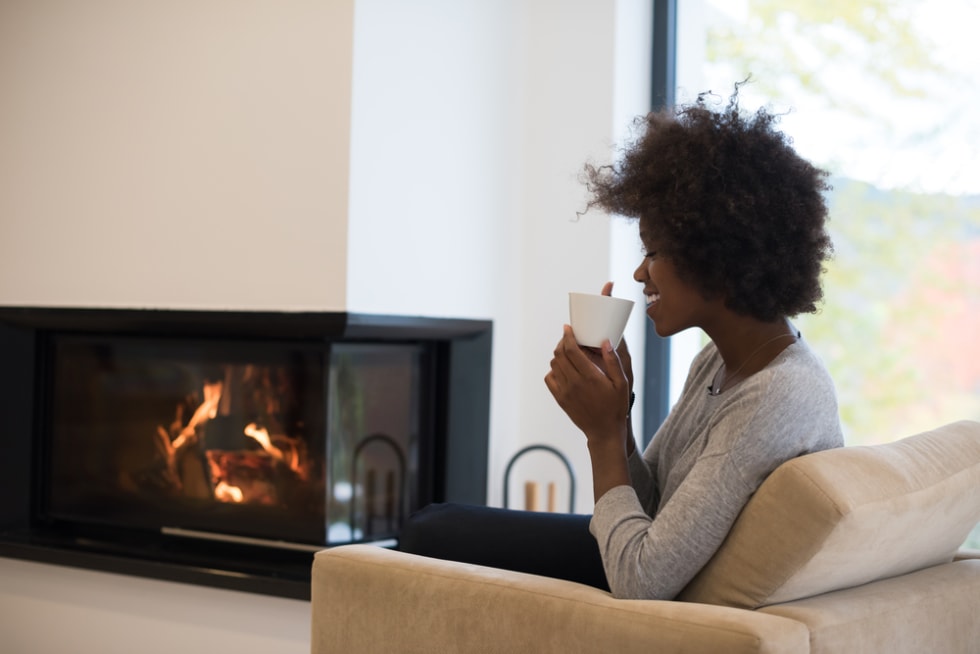
While fireplaces in apartments are usually straightforward, they may require a little detective work to get started.
Your landlord or property management likely left a fireplace operation manual for reference. If not, look for clues about your fireplace model or find a manufacturing sticker to look up the operating guide online. However, doing some Google sleuthing should also direct you to the right place to start.
Modern fireplaces often have a light switch on a wall nearby that turns them off and on, making them easy to use. Make sure you don't have a fireplace damper that needs to be opened before flipping the switch.
It's not uncommon for gas fireplaces to need a little coaxing before they turn on. Look underneath the fireplace wood rack where your gas logs are held. If there is no blue flame, your pilot light probably isn't lit.
There should be a manual switch somewhere near the gas logs that you press in to ignite the flame. You also might also see a dial to turn up the gas. Once the pilot light is lit, you can typically leave it as is, even when you don't have a fire going. Proceed slowly and take your time testing things to see what works.
Ventless fireplaces can aggravate respiratory issues and make you feel ill if the air doesn't circulate properly. However, all fireplaces emit some gas, which is why you should keep a window open when they’re in use.
If you have a wood-burning fireplace, you'll need to light a log to get it going. Dousing gas or other combustible fluids on the logs or newspaper is dangerous and could lead to injury or an apartment fire. Instead, try lighting some paper underneath the logs and see if the flame catches. Another option is a ready-to-go Duraflame log. Light the wrapper and watch the log burn for hours.
A fireplace cover is essential to keep hot embers from landing on your carpet or furnishings. A screen can also prevent injury if you're sitting too close to the flames.
One of the cardinal sins of apartment fireplace safety is leaving your fire unattended. Even if the fire looks low and well-contained, anything could happen. If a scrap of paper floats by, the gas sputters, or your mesh screen falls, you could end up with an apartment fire and put the safety of all of your neighbors at risk.
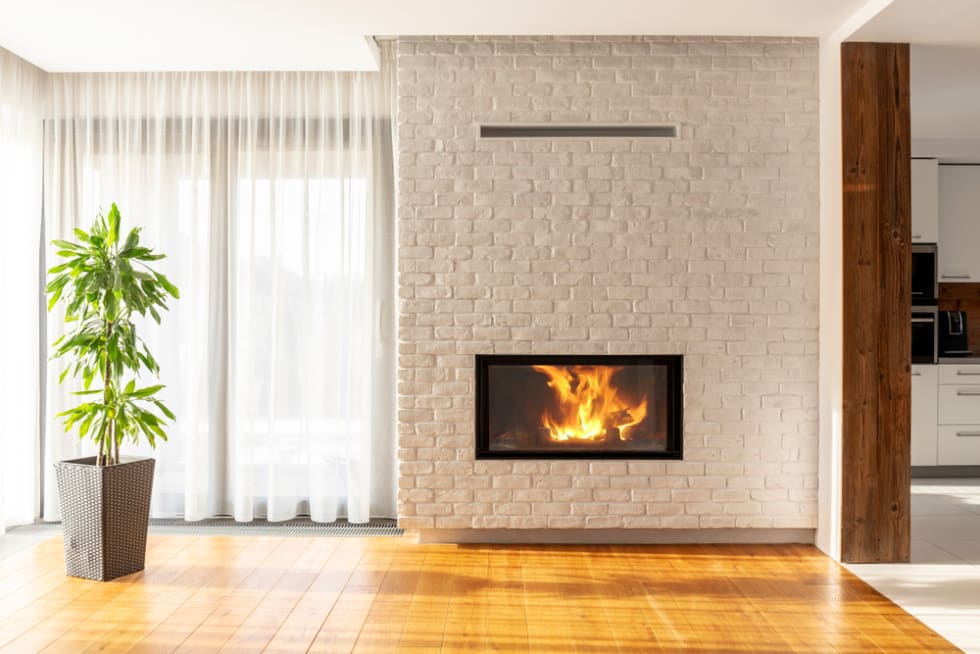
While your fireplace may look and feel amazing, there are essential safety measures to consider before you operate one.
A fire extinguisher is always a good safety measure no matter you live, though it is essential to have one handy when there's a fireplace in your apartment. If you live in a townhouse with multiple levels, make sure you have a fire extinguisher on each floor.
Gas fireplaces that run on natural gas or propane can cause issues. If you leave your fireplace on too long or your unit is failing, you may experience a gas leak. It's important to know your fuel source to make sure it's serviced and any fuel is replaced correctly.
Your fireplace may be ventless and damper-less. However, wood-burning fireplaces are required to have dampers to keep your home or apartment safe. The damper is a metal door that closes off your chimney flue from the fireplace.
Cold air and bugs are kept out, and your apartment stays warm and bug-free. However, you should leave your flue open for a little while after a fire to clear out any toxins and freshen the air.
Make sure to clear everything away from your fireplace for optimal safety. An ember could ignite a rug, papers, or books sitting on your hearth.
Without a fireplace cover or screen, you're at risk of things falling into your fireplace or getting burned. If you have children or pets, fireplaces can also leave them vulnerable from accidentally being burned by your fireplace.
Fires can smolder even if you think you put them out, making it crucial to keep your smoke alarms in working order and have extra batteries on hand. It's also possible some debris drifted into your fireplace and could ignite when you're not around. Falling asleep with a warm fire roaring is also a hazard in an apartment, and a working smoke alarm could make all the difference in your safety.
Gas, electric, and wood-burning fireplaces all emit some levels of carbon monoxide. While an open damper can help, ventless fireplaces need the assistance of carbon monoxide detectors. Make sure your carbon monoxide detectors are in working order, test them regularly, and keep extra batteries on hand.
You also never know when your chimney or fireplace may be experiencing failure and releasing more noxious gasses than you realize.

If you love the look of a fireplace but can't have one of your own in your apartment, there are alternatives to creating a similar ambiance.
Enjoy the look of a real fireplace with faux logs or electric lights that look like the real thing. However, make sure any electric heaters that look like fireplaces are okayed by your landlord. They may require a particular outlet, otherwise, they could create electrical damage to your apartment.
Real and electric candles look elegant and cozy when arranged in a non-working fireplace. You can also buy a fireplace rack designed to hold candles instead of wood. Light them up and watch their flames dance around in your fireplace.
If burning anything in your apartment isn't an option, you can still take advantage of the mantel. Decorate it with electric candles, flowers, and photos to create an attractive display in your living area. You can also source portable mantels that are made to look real but simply move around like a bookshelf ready to turn any wall space into a fireplace.
If you have your heart set on a built-in fireplace in your apartment, then you're in luck! It's not difficult to find an apartment with a fireplace when you use Apartment List’s filters to narrow down your choices.
Ready to get started? Sign-up with Apartment List today to start your search for your perfect place.


In unit laundry, Patio / balcony, Granite counters, Pet friendly, Stainless steel, Walk in closets + more
In unit laundry, Hardwood floors, Dishwasher, 24hr maintenance, Stainless steel, Walk in closets + more